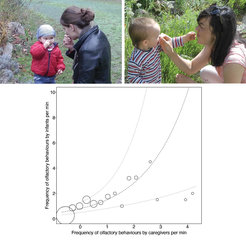PLANTing the Seeds of a Novel Research Area
Although it may be uncontroversial that plants have shaped the human mind in some way, without the right theoretical tools the precise consequences of their impact may be less obvious. This is especially true because of the seemingly minor role plants play in our own lives. This makes it difficult to imagine their potential consequences for human cognition using our own intuition. An evolutionary approach is invaluable in this case. It allows us to formulate hypotheses about how the kinds of interactions humans have had with plants over evolutionary time have impacted the human mind. We use an adaptationist approach that couples what is known about human ancestral environments with analyses of selection dynamics and evolutionary principles to make testable predictions about the design of human cognitive systems. This approach can be (and is) used with any aspect of the human mind. Importantly, it makes concrete predictions that can be tested and falsified in modern populations using standard methods.
The adaptationist logic for the predicted structure of human cognitive systems for plants is relatively straightforward. As outlined above, humans have a long evolutionary history with plants and have used plants in a variety of ways, including as food and raw materials for constructing artifacts. At the same time, plants can inflict serious harm. In order to protect themselves from herbivores, all plants produce toxic chemicals, many of which can be harmful or even fatal to humans when ingested. Some plants also have mechanical defenses like thorns and stinging hairs, or excreting toxins that can cause serious skin injury and even systemic effects. Therefore, the fundamental problem humans have had to solve with respect to plants is to determine which ones are food (or otherwise useful) and which are fatal. This turns out to be a difficult task.
Plants are in co-evolutionary relationships with a multitude of different herbivorous species. This means that plants have evolved features that are tailored to the sensory systems and physiologies of animals that are very different from humans, and very different from each other (e.g., insects, birds, ungulates, etc.). As a result, from a human perspective there are no morphological features common to all edible or to all poisonous plants. This means that simple rules like “all purple fruits are edible” or “plants with white flowers are poisonous” simply do not work (Figure 1). Trial-and-error learning, in which an individual directly samples different plant species and experiences the consequences, is not an effective strategy for learning about plants. That individual would risk spending a considerable amount of time being ill, at worst even dying. Instead, these circumstances select for the evolution of social learning mechanisms to acquire information from other more knowledgeable individuals. This is a theoretical proposal that we have confirmed with evolutionary modeling work (Oña et al., 2019).

Upper-left image: ViktoriyaPavlova on Pixabay, original image licensed under CC0
Lower-left image: MabelAmber on Pixabay, Pixabay-License
Upper-right image: adapted from “Lily of the valley” by kallu on flickr; original image licensed under CC BY-SA 2.0
Lower-right image: Mareefe on Pixabay, Pixabay-License
The specific proposal is that humans possess a collection of specialized social learning systems that balance the costs and benefits of interacting with plants, called Plant Learning and Avoiding Natural Toxins, or PLANT (Wertz, 2019). This novel proposal was at the heart of the work of the MPRG Naturalistic Social Cognition and the paper won the inaugural 2023 Don Symons Adaptationism Award from the Human Behavior and Evolution Society for best exemplifying the adaptationist program. The group’s work was primarily conducted with infants and young children because we were most interested in the structure and operation of these specialized social learning systems at the earliest stages of life, when individuals have the least experience and the most to learn. Our research team was comprised of psychologists and biologists. We specialized in infant cognition, evolutionary psychology, developmental psychology, and visual perception. We ran the MPI for Human Development BabyLab from 2015 to 2023, conducted our studies in kindergartens throughout Berlin, and established collaborations to examine PLANT systems in infants and young children in different cultures and in a variety of non-human primate species. Our primary measures were infant visual attention, including eye tracking; systematic coding of behaviors exhibited by infants and young children across different cultures; and structured tasks that assessed cognitive capacities early in development and in non-human primates.
To be clear, the PLANT proposal does not entail a single bounded module for learning about plants. In fact, in collaboration with David Pietraszewski, a Research Scientist in the Center for Adaptive Rationality (ARC), we have put forward a larger theoretical argument for why claims of functional specialization made by evolutionary psychologists are distinct from claims of Fodorian modularity, and that the field would, as a whole, be better off abandoning “modularity” (Pietraszewski & Wertz, 2022). Instead, the proposal is that PLANT is a collection of specialized systems that shares cognitive architecture with many other areas, including threat learning and danger avoidance, social learning, cultural transmission, food learning, foraging, artifact reasoning, object identification, and visual perception, among others. As a result, the PLANT proposal is generative and wide-reaching. It provides a fresh lens for viewing established problems and has led to the discovery of novel aspects of human cognition.
To date, we have accumulated quite a bit of evidence for certain aspects of the design of PLANT systems from our studies of human infants. This includes evidence for a behavioral avoidance strategy that would mitigate plant dangers like poisoning and skin injury. Unlike dangerous animals, plants cannot move around on their own. They are, quite literally, rooted to the spot. This means that a dangerous plant cannot inflict serious damage unless one approaches the plant and makes physical contact with it by, for example, grabbing it or consuming part of it. As a result, a simple behavioral strategy of minimizing physical contact with plants can be quite effective in minimizing exposure to plant dangers. Consistent with this proposal, our work shows that 8- to 18-month-old infants are indeed reluctant to touch plants compared to feature-matched control objects. We have replicated this novel finding in seven different studies investigating different aspects of the proposed behavioral avoidance strategy. Our recent work has shown, for example, that infants also avoid touching plant parts like leaves and fruits, although not to the same extent as whole leafy plants growing from soil (Rioux & Wertz, 2021), and that watching an adult touch plants reduces infants’ own plant avoidance (Włodarczyk et al., 2020).
Of course, many infants grow up in cultures that have much closer contact with plants in their everyday lives than infants from Berlin typically do. Therefore, we established collaborative cross-cultural projects to examine how infants growing up immersed in natural environments respond to plants. For example, in collaboration with Rita McNamara at Victoria University of Wellington, New Zealand, we conducted a study with Indigenous iTaukei Fijians and found that in contrast to German infants, who are avoidant of all plants, Fijian infants are only avoidant of plants that are unfamiliar to them (McNamara & Wertz, 2021). The source of these intriguing patterns of cross-cultural similarities and differences remains to be investigated, but the results demonstrate for the first time that cultural context impacts the development of PLANT systems.
Our recent findings underscore the importance of social learning for plants. We replicated an earlier finding that infants engage in increased social information seeking when they are confronted with plants (Rioux & Wertz, 2021); infants look more often to adults in the time before they touch plants, which would allow them to observe social cues before making contact with potentially harmful plants. We also recently completed data collection for a project replicating and extending our initial findings that 6- and 18-month-old infants selectively learn about plant edibility from adults’ social cues. Finally, our naturalistic observations of toddlers and their caregivers in the gardens surrounding the MPI for Human Development revealed the importance of olfactory cues when exploring plants. Toddlers and their caregivers spontaneously explored the scents of different plants by rubbing their fingers on the plants and smelling the residue, and a higher frequency of olfactory behaviors in caregivers corresponded to a higher frequency of these same behaviors in toddlers (Fantasia et al., 2021).

Images above: MPI for Human Development
Image below: Fantasia et al. (2021); Infant Behavior and Development
Taken together, the work of the MPRG Naturalistic Social Cognition established a new research area within the field of cognitive development. Some aspects of this work were entirely novel, for example, the discovery of a behavioral avoidance strategy for plants in infancy. Other aspects of this work dovetail with broader research areas within the cognitive sciences and expand existing lines of inquiry along new dimensions.
Collaborative Research Projects
In addition to our primary research agenda, members of the MPRG Naturalistic Social Cognition engage in collaborative projects to investigate various aspects of cognition in humans and non-human primates. In this reporting period, these projects have largely centered on studies of food cognition in children and adults (e.g., Lafraire et al., 2020; Coricelli et al., 2022) and comparative studies of social cognition and communication in non-human primates and canines (e.g., Bohn et al., 2022; Epperlein et al., 2022). The comparative research projects were conducted with researchers at the MPI for Evolutionary Anthropology and the MPI for Geoanthropology, among others.
Key References

